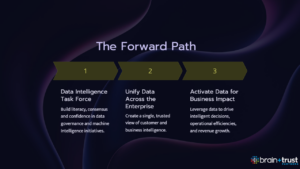Getting to know your customers and understanding their wants, needs, and pain points is critical to offering them a solution that works for them — but how do you find that out? In the recent past, companies developed “personas” to help shape their marketing, and they built those personas using their ideas of who their customers were. Sometimes, those ideas and assumptions were spot-on, and the product was a hit. Other times? Not so much.
Today, companies don’t have to guess. With all the data that consumers generate minute-by-minute, it’s never been easier to understand your customers and what they’re looking for. The challenge is finding that data, interpreting it meaningfully, and acting on it before your competitors do. And now: the race is on!
Get Your Data Ready
Once you’ve defined your overall audience, the next step is to determine how to best collect and organize the data they’re generating — and the best place to start is in your existing tools and platforms.
Take a good look at your systems. Do you have a CRM? A billing system? Customer service software? Inventory management software? Marketing automation? How about your website and marketing channels — all of your systems are collecting some customer data, but are they communicating with one another, and do you have any means of resolving and tracking new data generated by customer behaviors?
The good news is this: you already have more data than you know, and various teams within your organization are actively and continuously capturing it. The task at hand is figuring out how to bring all of this disparate data into a platform that can act as your single source of truth, creating a complete view of the customer.
Maintaining that complete customer view isn’t just something your business needs to maintain a competitive advantage. Sooner rather than later, it’s going to be something that your business is required to do. After all, just about every North American government is moving forward on data privacy rules backed by heavy fines that can and will hurt business owners, but the teeth of the resulting laws can be used as a prescription for cleaning up and managing all the righteously gained information and buying signals that your customers have shared with you. That information — that data — needs to be unified and resolved, such that it recognizes individuals across the chasms that exist between your existing systems, and that place where all that unified, resolved data lives is your customer data platform.
Customer Data Platform (CDP)
At its core, a customer data platform, or “CDP.” is where all your customers’ information lives. The CDP helps to organize that data, resolve customer and account identities, and helping to generate new insights about the people who make your business possible. Done right, a CDP gives teams across your organization easy access to reliable and, crucially, accurate information about your customers, enabling better, more accurate predictions of their future behavior.
With the right CDP in place, organizations have the ability to:
- Identify new customer segments,
- reduce spending waste, redundancy, and sales friction within your operations,
- better inform marketing, sales, and customer service/support leaders,
- improve the customer experiences – inbound, offline, and online,
- maintain privacy compliance and offer enhanced privacy;
- capitalize on media content and marketing automation;
- accelerate product and service development; and,
- much, much more!
Change Your Customers’ Profiles as Quickly as They Do
Just like your customers are living people, your customer profiles are living documents. It’s not enough to create contact records and profiles and leave them be – your customers’ interactions with your business, your products, and the communities around them are shaping their future needs. They’re maturing and changing, and you don’t know them if you’re not tracking those changes.
Your business needs to mature and grow with your customer base, and your data management needs to change. Not just from generation to generation, but from week to week, day by day, and minute by minute.
Even tracking all that user-generated data, though, isn’t the end of it. To ensure you capture more nuanced information about the needs of your current customers — the people using your product or service in the real world — you need to interview the people on your team who have direct contact with those customers. Those people may be marketing reps who handle customer outreach, salespeople or account managers interacting with clients on a daily basis, product managers responding to technical questions, or support staff fielding customer support calls.
These people know your systems and your customers and can provide great insight into what customers respond to most positively. What’s more, understanding their pain points will inform not just your customers’ experience, enrich your customer profiles, and help you pull even more signals from the noise of data.
All of this information is important enough to make the difference between keeping a valuable customer or losing them to your competitor – but without a properly managed CDP, you’re just collecting the dots, without connecting them.
Your Success Depends on Knowing Your Customers Better Than Your Competitors Do
Your customer base is changing daily – and if you thought the customer landscape changed quickly in the dawn of the digital era, hold on. Even more significant change is on the way. Your customers want to be heard, feel listened to, and want to matter to the brands they trust and buy from. They demand that their needs be met and that they’re served an experience tailored to them.
The golden rule is no longer “do unto others as you would have them do unto you,” but “do unto others as they would have done unto them.” But how can you deliver that on special, personal experience for your customers without knowing who your customers are? How can you personalize their experiences without knowing what matters most to them?
The knowledge you need to truly know your customers is buried in the data silos across your organization, making it impossible for even the most seasoned sellers, creative marketers, or visionary leaders to mine it. Now is the time to change that.
ORIGINAL CONTENT FROM brain+trust PARTNERS — last update 09MAR2023.
Co-authored by Tim Hayden & Jo Borrás







